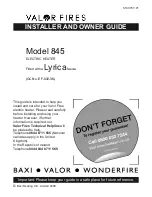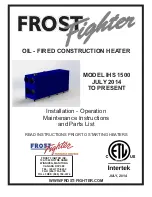
www.graf.info
17 / 40
5. Installation
5.1 Foundation
The following criteria must be verified prior to installation:
The structural suitability of the soil in accordance with DIN 18196
Maximum groundwater levels / drainage of the subsoil
Types of loading present, e.g. traffic load
A soil survey should be requested from the local building authority to determine the physical properties of
the soil.
5.2 Trench
To ensure that sufficient working space is available, the base area of the trench must exceed the tank
dimensions by 500 mm on all sides. The distance from fixed structures must be at least 1000 mm.
The embankment should be built in accordance with DIN 4124. The foundation must be horizontal and
even and must offer sufficient load-bearing capacity.
The trench must be deep enough that the maximum earth cover above the tank (see 2 - Installation con-
ditions) is not exceeded. For the system to be usable all year round, the tank and water-carrying parts
must be installed in a frost-free zone. The frost-free depth is usually around 600 mm-800 mm; for accu-
rate information, please contact the responsible authority.
The substructure is made from a layer of compacted round gravel (grain 8/16, approx. 150-200 mm thick).
5.2.1 Positioning on a slope, embankment etc.
If the tank is installed in immediate proximity (less than
5 m) to a slope, mound or embankment, a statically cal-
culated supporting wall must be constructed to bear the
pressure of the soil. The wall must exceed the tank di-
mensions by at least 500 mm in all directions and must
be at least 1000 mm away from the tank.
5.2.2 Groundwater and cohesive (non-water-
permeable) soils (e.g. loam)
Sufficient drainage of the groundwater / seeping water
should be ensured if groundwater only occurs occasion-
ally and if the soils are cohesive and water-impermeable
(e.g. loam) so that the tanks never stand in more
groundwater than is stated in the table. If necessary, the
drainage pipe must end in a vertical DN 300 pipe in
which
a submersible pressure pump is fitted to pump out the
excess water. The pump should be checked regularly. If
the tanks are expected to be immersed deeper, sufficient
drainage should always be ensured.
We generally recommend laying a drainage pipe because
the ground water level may rise unexpectedly during long
periods of rain.
5.2.3 Installation next to driven-on surfaces
If the underground tanks are installed next to roadways
used by heavy vehicles of more than 40 t, the minimum
distance from these surfaces must be at least the depth of
the trench.
Tank size
all tank sizes
Submersion depth
1275 mm
















































